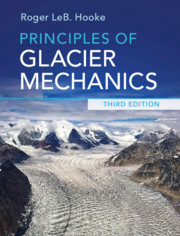Book contents
- Principles of Glacier Mechanics
- Reviews
- Principles of Glacier Mechanics
- Copyright page
- Dedication
- Contents
- Preface to the third edition
- Preface to the second edition
- Preface to the first edition
- Physical constants relevant to ice
- Derived SI units and conversion factors
- 1 Why study glaciers?
- 2 Some basic concepts
- 3 Mass balance
- 4 Flow and fracture of a crystalline material
- 5 The velocity field in a glacier
- 6 Temperature distribution in polar ice sheets
- 7 The coupling between a glacier and its bed
- 8 Water flow in and under glaciers: Geomorphic implications
- 9 Stress and deformation
- 10 Stress and velocity distribution in an idealized glacier
- 11 Numerical modeling
- 12 Applications of stress and deformation principles to classical problems
- 13 Ice streams and ice shelves
- 14 Finite strain and the origin of foliation
- 15 Response of glaciers to climate change
- 16 Ice core studies
- Problems
- References
- Index
3 - Mass balance
Published online by Cambridge University Press: 20 December 2019
- Principles of Glacier Mechanics
- Reviews
- Principles of Glacier Mechanics
- Copyright page
- Dedication
- Contents
- Preface to the third edition
- Preface to the second edition
- Preface to the first edition
- Physical constants relevant to ice
- Derived SI units and conversion factors
- 1 Why study glaciers?
- 2 Some basic concepts
- 3 Mass balance
- 4 Flow and fracture of a crystalline material
- 5 The velocity field in a glacier
- 6 Temperature distribution in polar ice sheets
- 7 The coupling between a glacier and its bed
- 8 Water flow in and under glaciers: Geomorphic implications
- 9 Stress and deformation
- 10 Stress and velocity distribution in an idealized glacier
- 11 Numerical modeling
- 12 Applications of stress and deformation principles to classical problems
- 13 Ice streams and ice shelves
- 14 Finite strain and the origin of foliation
- 15 Response of glaciers to climate change
- 16 Ice core studies
- Problems
- References
- Index
Summary
In this chapter, we find that snow accumulation and its transformation to ice lead to stratigraphy that persists for thousands of years and can be used to date ice. A perturbation analysis is then used to show that net balances are sensitive to summer temperature in continental areas and to both winter balance and summer temperature in maritime ones. Radiation balance could play a role in either environment. Dynamic thickening or thinning, and terminus advance or retreat are found to be closely linked. A rapid advance accompanied by commensurate thinning does not change mass. However, an advance may result in rapid terminus melting and retreat. Calving and bottom melting are also important mass balance components. On tidewater glaciers calving can lead to retreats unrelated to climate. Calving is a dominant process of mass loss on ice sheets. Bottom melting is important on some valley glaciers and ice shelves. Variations in atmospheric circulation patterns may result in asynchronous mass-balance patterns on glaciers only a few hundred kilometers apart. Finally, estimates of global mass balance, and their contribution to sea level rise are summarized.
Keywords
- Type
- Chapter
- Information
- Principles of Glacier Mechanics , pp. 17 - 45Publisher: Cambridge University PressPrint publication year: 2019



